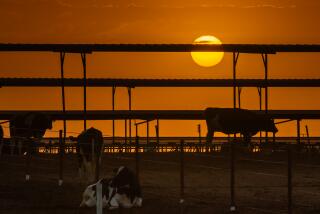Washington Calves Buried
- Share via
ROOSEVELT, Wash. — Holstein calves killed as a precautionary measure against mad cow disease were buried Wednesday at a landfill, a disposal method that state officials said would protect the public from any possible health threat.
A snowstorm had delayed federal officials’ plans to bury the herd of 449 calves Wednesday, but by late afternoon two trucks containing the animals had pulled up to the southern Washington landfill.
“They had a break in the weather, and [the calves] were taken to the landfill,” U.S. Department of Agriculture spokesman Nolan Lemon said Wednesday evening.
USDA veterinarians and other federal workers had sedated and lethally injected the herd at a vacant slaughterhouse in northeast Washington by late Tuesday, Lemon said.
The calves were part of a herd that included the offspring of a Holstein infected with mad cow disease that came from Canada. The Holstein, slaughtered Dec. 9, was diagnosed with mad cow disease Dec. 22, becoming the first and only cow in the United States found with the brain-wasting illness.
Mad cow disease, or bovine spongiform encephalopathy, eats holes in the brains of cattle. Humans can develop a brain-wasting illness from consuming contaminated beef products.
Agriculture officials said the herd had to be killed because the calf born to the sick cow had not been tagged and could not be identified. They have been unable to rule out the possibility that mad cow disease can be transmitted from mother to calf.
The infected cow was born at a dairy farm in the Canadian province of Alberta and came to the United States two years ago. The only other case of the disease in North American-born cattle was discovered in May, in a cow from an Alberta herd.
Several Democrats, including Senate Democratic leader Tom Daschle of South Dakota, announced their support Wednesday for testing all cattle at slaughter. USDA officials have said they are considering a range of options, including more extensive testing.
The United States restricted imports of Canadian beef after the May case of mad cow but reopened the border to some beef cuts in October. Canadian officials are pushing for the further opening of markets.
The landfill where the USDA buried the calf carcasses, near Roosevelt, is considered one of the most secure in North America, according to Rabanco Regional Disposal, a company that contracts with Klickitat County to operate it.
“Once we get them covered up, the risk is very close to zero,” said Kevin Barry, the county’s director of public health. His agency regulates the landfill.
More to Read
Sign up for Essential California
The most important California stories and recommendations in your inbox every morning.
You may occasionally receive promotional content from the Los Angeles Times.










